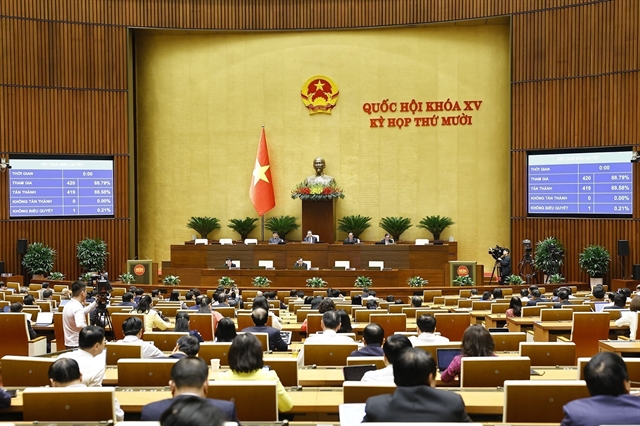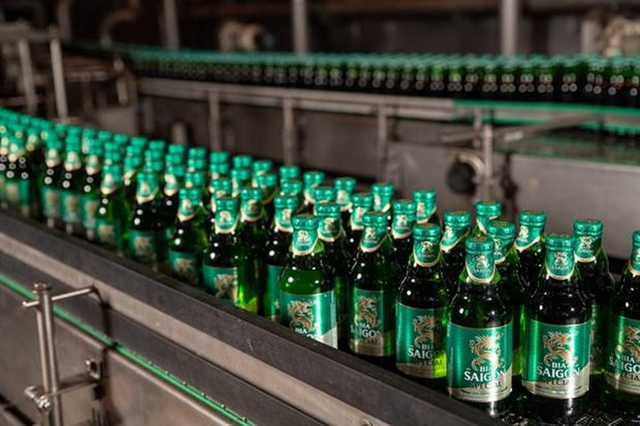 Economy
Economy


|
| A production line of Sabeco. In 2019, the total beer production will reach more than 5 billion litres. — Photo vietnamplus.vn |
HÀ NỘI — Việt Nam’s beer market is forecast to see big opportunities this year, as the country has always been held great potential for domestic and foreign beer enterprises. Fierce competition is incoming, as more foreign brands are looking to tap the market.
The information was released in the Việt Nam Industry Research and Consultancy (VIRAC)’s latest report.
With a population structure among the youngest in the world – 56 per cent of the population is under the age of 30 – Việt Nam Beer Association (VBA) predicts that total consumer expenses in Việt Nam will double and reach approximately US$173 billion by 2020.
According to a Nielsen report, 56 per cent of Vietnamese consumers are under 30 years old and Việt Nam’s middle class will double from 12 million (in 2014) to 33 million (in 2020). It is estimated that Việt Nam will have two million more consumers joining the middle class, becoming the fastest-growing middle class segment in Asia.
The strong export markets of Việt Nam, such as ASEAN countries and China, are all markets with high growth in food and beverage consumption. Along with a series of free trade agreements, Vietnamese food and beverages have been largely able to access key free export markets (without tariffs).
In the context of international economic integration, mergers and acquisitions (M&A) will contribute to raise the size, competitiveness, market share, reputation and efficiency of larger businesses and start a new development cycle.
For example, Thai Beverage, a company owned by a Thai billionaire, spent VNĐ110 trillion ($4.8 billion) to buy 53.59 per cent of Saigon Beer Alcohol and Beverage Company (Sabeco) in December 2017. This is not only the largest M&A deal in Việt Nam’s history, but also the largest M&A deal in the Asian beer industry.
Beer consumption
In 2019, the total beer production will reach more than five billion litres (up 22.9 per cent over the same period in 2018); consumption reached over four billion litres (up 29.1 per cent over the same period last year). Beer sales reached over VNĐ65 billion (up 0.5 per cent over the same period last year). Regarding types of consumption, canned beer consumption accounted for 66.8 per cent of total beer consumption in Việt Nam, followed by bottled beer 29.9 per cent; while draft beer is 3.1 per cent and accounts for a modest market share of fresh beer at 0.1 per cent.
Regarding imports, the imported beer output reached more than 37 million litres (an increase of 8.9 per cent compared to the same period in 2018). The three main sources of beer supply in Việt Nam are the Netherlands (25 per cent), Mexico (17 per cent) and Belgium (16 per cent). Compared to beer consumption in Việt Nam, beer imports into the country account for a relatively small proportion. Domestic and FDI beer enterprises dominate the domestic market, with the advantage of cheap beer prices, which suits the taste of the majority of customers.
Regarding exports, the export beer output increased 46 million litres over the previous year, reaching $45.87 million. The export volume decreased by about 7 per cent over the same period. The main reason is that Việt Nam’s beer quality has not been highly appreciated and not created a brand in the international market. Equatorial Guinea (about 20 per cent) is the largest market for Vietnamese beer.
Challenges
The law coming into effect on January 1 has been effective in adjusting the drinking habits of many people. It is forecasted that the beer industry growth rate in the year will not maintain the double-digit level as in previous years; reach 6-7 per cent in the following years, although each year Việt Nam has 1 million more people of legal age to drink alcoholic beverages.
In the stock market, shares of the two “giants” in the beer industry, Sabeco and Habeco, have dropped from 0.4 per cent to 0.8 per cent. Meanwhile, the share value of the entire industry will decline by nearly 13 per cent in 2019. Experts predict that the beer and wine industry will adjust towards a shrinking trend by 2020, in which small businesses will be most affected.
Alcoholic beverages in Việt Nam have to pay taxes at two stages of import and domestic consumption, including three different taxes: import tax (from 5-80 per cent depending on type of FTA), tax value added (10 per cent) and excise taxes (up from 50 per cent to 65 per cent in 2018). This can affect the profitability of beer companies, especially those in the mid-end segment, as this is a competitive segment and customers are most vulnerable to the impact of the best-selling prices.
Production license can be considered a major obstacle for new businesses. To open a beer factory in Việt Nam, businesses must be licensed by the Ministry of Industry and Trade. While the regulations are quite clear, implementation can be difficult. Even if all provinces were willing to facilitate new breweries to collect taxes, the licensing would depend on the beer and beverage planning of the ministry, which may have been registered many years in advance.
According to VIRAC, Việt Nam’s beer industry still faces many challenges such as communication, risks of changing consumer tastes and M&A, requiring continuous efforts and improvement to enhance the position in the international market. — VNS




.jpg)